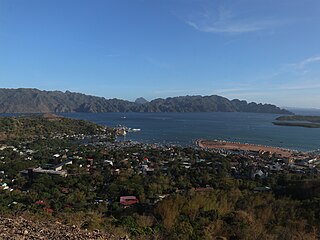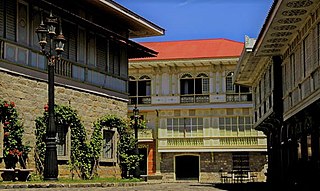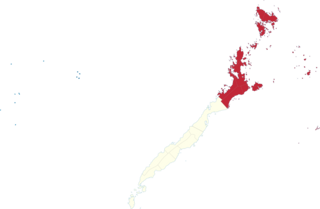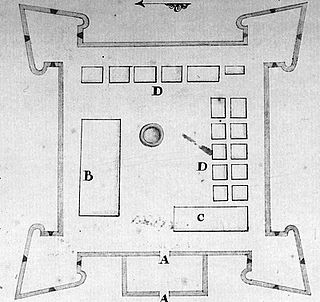
A fortification is a military construction designed for the defense of territories in warfare, and is used to establish rule in a region during peacetime. The term is derived from Latin fortis ("strong") and facere.

Palawan, officially the Province of Palawan, is an archipelagic province of the Philippines that is located in the region of Mimaropa. It is the largest province in the country in terms of total area of 14,649.73 km2 (5,656.29 sq mi). The capital and largest city is Puerto Princesa wherein it is geographically grouped but administered independently from the province. Palawan is known as the Philippines' Last Frontier and as the Philippines' Best Island.

Iloilo, officially the Province of Iloilo, is a province in the Philippines located in the Western Visayas region. Its capital and largest city is Iloilo City, the regional center of Western Visayas. Iloilo occupies the southeast portion of the Visayan island of Panay and is bordered by the province of Antique to the west, Capiz to the north, the Jintotolo Channel to the northeast, the Guimaras Strait to the east, and the Iloilo Strait and Panay Gulf to the southwest.

Busuanga, officially the Municipality of Busuanga, is a 3rd class municipality in the province of Palawan, Philippines. According to the 2020 census, it has a population of 25,617 people.

Coron, officially the Municipality of Coron, is a 1st class municipality in the province of Palawan, Philippines. According to the 2020 census, it has a population of 65,855 people.

Brooke's Point, officially the Municipality of Brooke's Point, is a 1st class municipality in the province of Palawan, Philippines. According to the 2020 census, it has a population of 73,994 people.

Culion, officially the Municipality of Culion, is a 3rd class municipality in the province of Palawan, Philippines. According to the 2020 census, it has a population of 23,213 people.

Puerto Princesa, officially the City of Puerto Princesa, is a 1st class highly urbanized city in the Mimaropa region of the Philippines. According to the 2020 census, it has a population of 307,079 people.

Cagayancillo, officially the Municipality of Cagayancillo, is a 6th class municipality in the province of Palawan, Philippines. According to the 2020 census, it has a population of 6,884 people.

Cuyo, officially the Municipality of Cuyo, is a 4th class municipality in the province of Palawan, Philippines. According to the 2020 census, it has a population of 23,489 people.

Magsaysay, officially the Municipality of Magsaysay, is a 5th class municipality in the province of Palawan, Philippines. According to the 2020 census, it has a population of 12,603 people.

Taytay, officially the Municipality of Taytay, is a 1st class municipality in the province of Palawan, Philippines. According to the 2020 census, it has a population of 83,357 people.
Palawan Broadcasting Corporation (PBC) is a Philippine media network. Its corporate office is located in Puerto Princesa.

The Order of Augustinian Recollects (OAR) is a mendicant Catholic religious order of friars and nuns. It is a reformist offshoot from the Augustinian hermit friars and follows the same Rule of St. Augustine. They have also been known as the "Discalced Augustinians".

The architecture of the Philippines reflects the historical and cultural traditions in the country. Most prominent historic structures in the archipelago are influenced by Austronesian, American architectures.

The Spanish fortifications of the Philippines, or fuerzas, are strongholds constructed by Filipinos and Spaniards primarily for protection against local and foreign aggressors during the Spanish colonial period, and during the subsequent American and Japanese occupations. Structures built included fortresses, watchtowers, and bastions. Many are badly damaged, either due to old age or past conflicts. Currently, there are initiatives for restorations of all forts, beginning when the Baluarte Luna of La Union and the Intramuros of Manila were restored in the 2010s. In 2013, a typhoon and earthquake hit Central Visayas and damaged numerous Spanish fortifications, leading to the largest restoration activity for fortifications in Philippine history.

The Apostolic Vicariate of Puerto Princesa is a Latin Church missionary jurisdiction or apostolic vicariate of the Catholic Church located in the Province of Palawan, Philippines. Its cathedra is within Immaculate Conception Cathedral in the episcopal see of Puerto Princesa City, Palawan, Philippines. It is not a part of an ecclesiastical province as it is directly exempt to the Holy See, specifically the Congregation for the Evangelization of Peoples, yet for the purpose of apostolic cooperation usually grouped with the Archdiocese of Manila, along with the Roman Catholic Apostolic Vicariate of Taytay. The current Vicar Apostolic is Bishop Socrates Calamba Mesiona.

The Fort of Saint Vincent Ferrer or commonly known as Punta Cruz Watchtower (Tagalog: Bantayan ng Punta Cruz) is a Spanish colonial era watchtower located at the western tip of the municipality of Maribojoc, Bohol, Philippines. Also known as Maribojoc Watchtower because of its geographical location, it is located three kilometers (1.9 mi) away from Maribojoc Church. It is known for being the "only perfect isosceles triangle" tower-fort structure in the Philippines.

Palawan's 1st congressional district is one of the three congressional districts of the Philippines in the province of Palawan. It has been represented in the House of Representatives since 1987. The district encompasses the northern portion of Palawan Island including the Calamianes, Cuyo and Kalayaan island chains. It consists of the municipalities of Agutaya, Araceli, Busuanga, Cagayancillo, Coron, Culion, Cuyo, Dumaran, El Nido, Kalayaan, Linapacan, Magsaysay, Roxas, San Vicente and Taytay. The district is currently unrepresented in the 19th Congress following the death of Edgardo "Egay" Salvame of the People's Reform Party (PRP) on March 13, 2024.

Fort Culion is a citadel built in 1740 during the Spanish-era in the Philippines. The Recollect Augustinians constructed the fort to defend themselves from Muslim invaders. The structure was built of stone, square-shaped, and with four bastions.





















